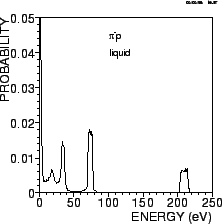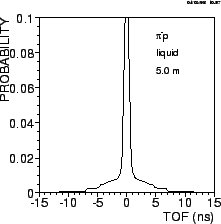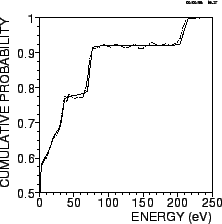Let ![]() be the normalized kinetic energy distribution of the exotic
atom, then the cumulative energy distribution
be the normalized kinetic energy distribution of the exotic
atom, then the cumulative energy distribution ![]() is defined by the
formula
is defined by the
formula
with the normalization condition having the form
 |
(34) |
where ![]() is the maximum kinetic energy.
is the maximum kinetic energy.
The neutron time of flight corresponding to the reaction
![]() at rest is
at rest is ![]() where
where ![]() is the neutron flight path and
is the neutron flight path and ![]() cm/ns
is the neutron velocity. The Doppler broadening of the neutron time-of-flight
spectrum
cm/ns
is the neutron velocity. The Doppler broadening of the neutron time-of-flight
spectrum ![]() , where
, where
![]() is the difference between
the measured time
is the difference between
the measured time ![]() and
and ![]() , is related to the kinetic energy distribution
, is related to the kinetic energy distribution ![]() by
by
where ![]() is speed of light and
is speed of light and ![]() is the
is the ![]() mass.
mass.
Given the Doppler profile ![]() , one can determine the cumulative
energy distribution
, one can determine the cumulative
energy distribution ![]() using the following formula which is derived straightforwardly
from Eqs. (37-40):
using the following formula which is derived straightforwardly
from Eqs. (37-40):
Equation (41) can be used for the determination of the kinetic energy distribution from the measured neutron ToF spectrum in a model independent way as illustrated in Figs. 11, 12 and 13.

|
|
Figure 11:
The calculated kinetic energy distribution of the
|
The theoretical kinetic energy distribution shown in Fig 11 corresponds
to the n-ToF distribution plotted in Fig. 12. Applying Eq. (41) to the Monte
Carlo generated spectrum ![]() with
with ![]() events we obtain
perfect reconstruction of the original kinetic energy distribution as shown
in Fig. 13.
events we obtain
perfect reconstruction of the original kinetic energy distribution as shown
in Fig. 13.
The Doppler broadening of the X-ray lines
![]() is
described by formulas similar to Eqs. (39,40):
is
described by formulas similar to Eqs. (39,40):
where ![]() is the transition energy. Therefore the same
method can in principle be applied for the kinetic energy distribution of the
muonic hydrogen from the Doppler profile of the X-ray lines. In this case, however,
the limits of the final energy resolution are significant and proper corrections
must be applied before using the formulas mentioned above. The extension to
the case of pionic hydrogen, where the nuclear reaction widths should be taken
into account, is straightforward.
is the transition energy. Therefore the same
method can in principle be applied for the kinetic energy distribution of the
muonic hydrogen from the Doppler profile of the X-ray lines. In this case, however,
the limits of the final energy resolution are significant and proper corrections
must be applied before using the formulas mentioned above. The extension to
the case of pionic hydrogen, where the nuclear reaction widths should be taken
into account, is straightforward.

|
|
Figure 12:
The calculated neutron ToF spectrum for the reaction
|

|
|
Figure 13:
The cumulative energy distribution W(E) reconstructed from the
nToF spectrum with
|